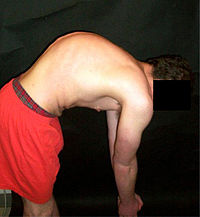
Photo from wikipedia
STUDY DESIGN Single-institution, retrospective review of prospectively collected data on pediatric patients with adolescent idiopathic scoliosis (AIS) undergoing spinal fusion with a minimum two-year follow-up. OBJECTIVE To determine the rate… Click to show full abstract
STUDY DESIGN Single-institution, retrospective review of prospectively collected data on pediatric patients with adolescent idiopathic scoliosis (AIS) undergoing spinal fusion with a minimum two-year follow-up. OBJECTIVE To determine the rate of reoperation in AIS patients undergoing spine fusion from 2008 to 2012. SUMMARY OF BACKGROUND DATA Recent trends in the surgical treatment of AIS have included increased use of all-pedicle screw constructs, smaller implants, more posterior-only approaches, and improved correction techniques. METHODS A retrospective review of 467 patients undergoing spinal fusion from 2008 to 2012 was performed. Demographic, clinical, radiographic, and surgical data were collected prospectively on all patients for the index procedure and any reoperations. Data were compared to previously published cohorts of patients from the authors' institution who underwent spinal fusion for AIS between 1988 and 2007. RESULTS The rate of reoperation in this five-year cohort of patients was 9.9%. The most common indications for reoperation were infection (4.5%: 2.4% delayed infections and 2.1% acute infections), symptomatic implants (2.1%), and misplaced pedicle screws (1.7%). When compared to the 2003-2007 cohort, the rate of reoperation for acute infection and malpositioned pedicle screws increased significantly (p = .01 and p = .04), whereas the rate of reoperation for curve progression decreased (p = .01). Reoperations for acute infections and malpositioned pedicle screws also increased significantly (p = .047 and p = .042) compared with the 1988-2002 cohort, whereas the rate of reoperation for pseudarthrosis decreased (p = .002). CONCLUSION Reoperation rates for AIS have not improved with more sophisticated implants and techniques, predominantly because of increased acute infections and malpositioned pedicle screws despite decreasing pseudarthrosis rates and curve progression. LEVEL OF EVIDENCE Level II.
Journal Title: Spine deformity
Year Published: 2018
Link to full text (if available)
Share on Social Media: Sign Up to like & get
recommendations!